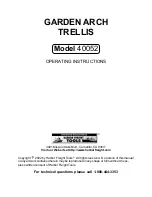
Optical Spectrum Analyzers
Chapter 4: Description
Rev D, June 16, 2022
Page 4
Chapter 4
Description
The Thorlabs Optical Spectrum Analyzer (OSA) is a general-purpose spectrum analyzer for optical research
and production applications. It has a user-friendly Graphical User Interface and can be controlled from a
standard PC via a High Speed USB port. Each instrument offers an FC/PC fiber input receptacle and a free-
space input for collimated beams. Special designs with other input receptacles are available on request. The
instrument is designed for measurements of continuous wave (CW) light sources, but works in some
applications where pulsed light is used. Please contact Technical support at
to
discuss your application if you have a pulsed source.
4.1.
Introduction
Thorlabs’ Optical Spectrum Analyzers are general-purpose instruments that measure optical power as a
function of wavelength. These OSA instruments are versatile enough to analyze broadband optical signals,
resolve the Fabry-Perot modes of a gain chip, and identify gas absorption lines in a spectral measurement.
Whereas commonly available OSAs are typically grating-based monochromators, the Thorlabs instruments are
Fourier Transform Optical Spectrum Analyzers (FT-OSAs), which utilize a scanning Michelson interferometer
design, as shown in Figure 1 and Figure 2 on pages 5 and 6. This approach allows for the design of a full-
featured OSA with the additional benefit of a high-precision wavelength meter.
Thorlabs offers two lines of analyzers, including the OSA20xC models and the Redstone OSA305 model. The
Redstone OSA305 is a more advanced instrument for demanding applications that require a higher optical
resolution or sensitivity whereas the OSA20xC instruments are general-purpose analyzers with moderate
resolution and high update rate.
The Thorlabs FT-OSA has an FC/PC-style optical fiber input and a free-space input. After the input light is
collimated, a beamsplitter divides the optical signal into two separate branches. The path length difference
between the two branches is varied up to a maximum of 40 mm for the OSA20xC instruments or 160 mm for
the Redstone OSA305. The collimated light fields then optically interfere as they recombine at the beamsplitter.
The detector units shown in Figures 1 and 2 record the interference pattern, which is commonly referred to as
an interferogram. This interferogram is the autocorrelation waveform of the input optical spectrum. By applying
Fourier transform to the waveform, the optical spectrum is recovered. The resulting spectrum offers both a high
resolution and a very broad wavelength coverage with a spectral resolution that is related to the optical delay
range. The wavelength range is limited by the optical bandwidth of the detectors and of the optical coatings.
The two main detectors of the Redstone OSA305 are responsive over different wavelength ranges, and the two
separate spectra can be stitched together to provide a single spectrum covering the entire device wavelength
range.
Furthermore, the accuracy of our system is ensured by including a frequency-stabilized HeNe reference laser
in the OSA20xC models and an infrared frequency-locked reference laser in the Redstone OSA305. The
reference lasers provide highly accurate measurements of optical path length changes, allowing the system to
continuously self-calibrate. This process ensures accurate optical analysis well beyond what is possible with a
grating-based OSA. The Redstone OSA305 also includes an additional detector and broadband source, which
is used to accurately determine the location of the point of zero path difference (ZPD).
4.2.
Interferometer Design
The OSA20xC models use an arrangement of two retroreflectors as shown in Figure 1. These retroreflectors
are mounted on a voice-coil-driven platform, which dynamically changes the optical path length of the two
branches of the interferometer simultaneously and in opposite directions. The advantage of this layout is that it
changes the optical path difference (OPD) of the interferometer by four times the mechanical movement of the
platform; the longer the change in OPD, the finer the spectral detail the FT-OSA can resolve.
The Redstone OSA uses a standard arrangement of one fixed and one movable retroreflector as shown in
Figure 2. The mobile retroreflector is mounted on a voice-coil-driven platform, which changes the optical path
length of the branch. The fixed retroreflector is mounted on a piezo actuator that translates the retroreflector in
the two dimensions orthogonal to the beam path in a self-alignment algorithm. This configuration changes the
OPD between the two branches by twice the mechanical movement of the platform. The Redstone OSA collects
asymmetrical interferograms in terms of the ZPD, which is located significantly closer to one end of the stroke.
These interferograms are usually called single-sided whereas the OSA20xC instruments collect symmetrical,
or double-sided, interferograms.
Содержание Redstone OSA305
Страница 1: ...Redstone OSA305 OSA201C OSA202C OSA203C OSA205C OSA207C Optical Spectrum Analyzers Manual ...
Страница 43: ...Optical Spectrum Analyzers Chapter 12 Mechanical Drawings Page 39 STN053070 D02 12 1 2 Front and Back Panels ...
Страница 45: ...Optical Spectrum Analyzers Chapter 12 Mechanical Drawings Page 41 STN053070 D02 12 2 2 Front and Back Panels ...
Страница 52: ...www thorlabs com ...









































